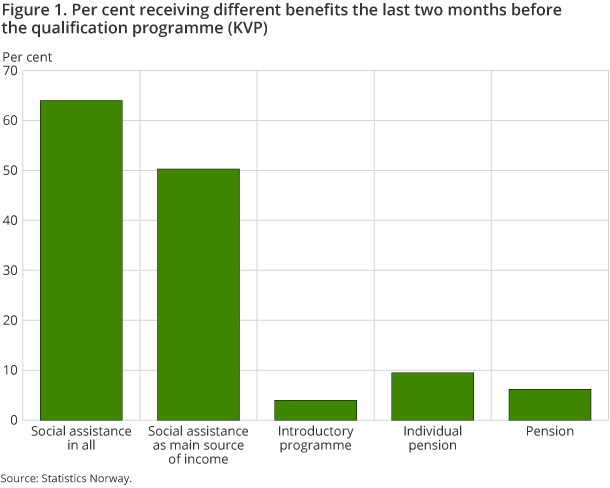Content
Published:
This is an archived release.
More in ordinary work after completing programme
Data from the qualification programme (KVP) for 2012 show that 29 per cent of participants who completed the course went on to ordinary work immediately afterwards; up from 24 per cent the year before.
| 2011 | 2012 | |
|---|---|---|
| Participants under 20 years | 1 | 1 |
| Participants 20-24 years | 20 | 19 |
| Social assistance as major income 2 months before KVP | 52 | 50 |
| Participants completed programme 31/12 | 31 | . |

In 2012, half of the participants had social assistance as their major source of income before entering the programme, which is in line with the figures for 2011. As for dependency during the programme, this proportion was reduced to 10 per cent, also in line with the previous year.
Of those who finished the programme in 2012, 28 per cent were dependent on social assistance as the main source of income afterwards. This level is about the same as last year. Dependency on pensions after the programme was further down, however, so that the net effect was a reduced dependency on public support.
More in ordinary work after programme
Twenty-nine per cent of participants completing their programme went to ordinary work in 2012, up from 24 per cent in 2011 and 21 per cent in 2010. The proportion leaving for different employment measures was also up. These figures are in line with the decreased dependency on public support noted above.
Regarding the contents of the programme, the most common activity was still work placements. Forty-six per cent participated in such placements during 2012. The second most important activity was employment measures (28 per cent). There are marked differences between younger and older participants as regards the contents of the programme. For instance, treatment regarding mental health was twice as common among participants under 25 years, while language training was seven times more common in the older age group.
Only 4 per cent of the KVP participants in 2012 interrupted their programme through absence. This number has been declining somewhat every year.
Nationally, one out of five participants were under 25. As the two preceding years, the county of Møre og Romsdal had the highest proportion of young participants (34 per cent), while in the capital of Oslo the share of young participants continued to be much lower than in the other counties, at only 5 per cent.
The statistics is published with Social assistance.
Contact
-
Statistics Norway's Information Centre
E-mail: informasjon@ssb.no
tel.: (+47) 21 09 46 42
